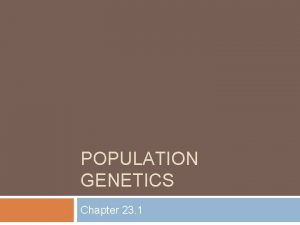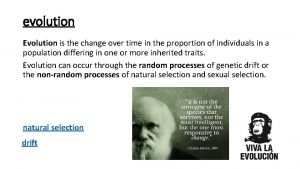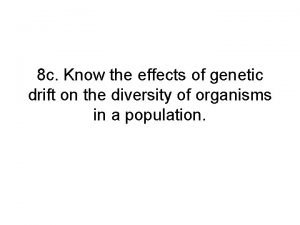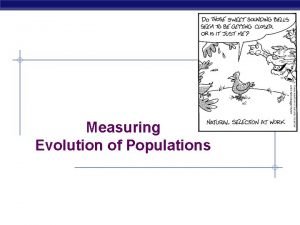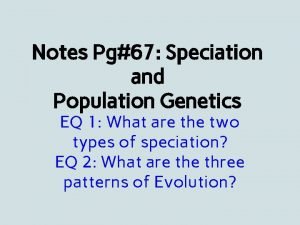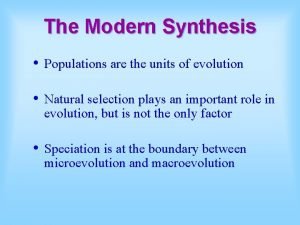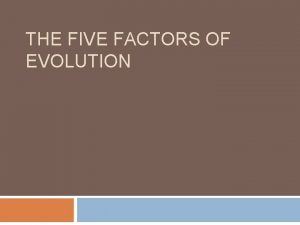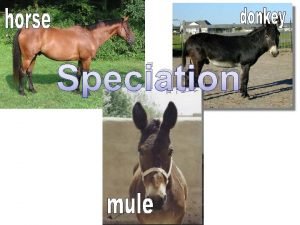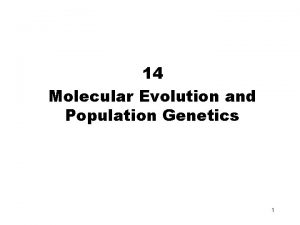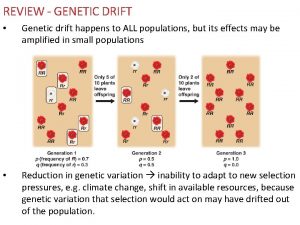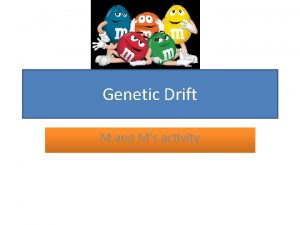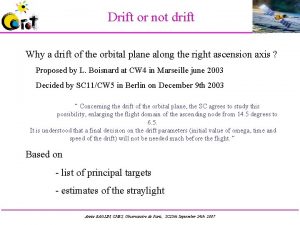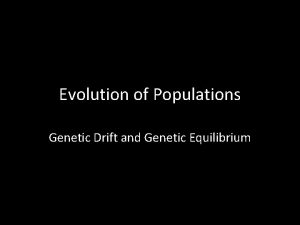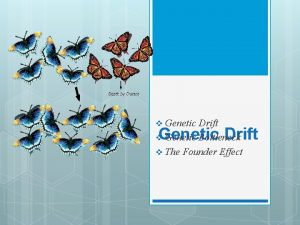Genetic Drift Genetic Drift In each generation some












- Slides: 12

Genetic Drift

Genetic Drift • In each generation, some individuals may, just by chance, leave behind a few more descendents (and genes, of course!) than other individuals. The genes of the next generation will be the genes of the “lucky” individuals, not necessarily the healthier or “better” individuals. That, in a nutshell, is genetic drift. It happens to ALL populations—there’s no avoiding the vagaries of chance. • Those alleles then become either more or less common in the population. • This all occurs by CHANCE!

Genetic Drift • Genetic drift affects the genetic makeup of the population but, unlike natural selection, through an entirely random process. So although genetic drift is a mechanism of evolution, it doesn’t work to produce adaptations.

Founder Effect • A founder effect occurs when a new colony is started by a few members of the original population. This small population size means that the colony may have: – reduced genetic variation from the original population. – a non-random sample of the genes in the original population.

Founder Effect

Founder Effect • Polydactyly -- extra fingers or sometimes toes -- is one symptom of Ellis-van Creveld syndrome. The syndrome is commonly found among the Old Order Amish of Pennsylvania, a population that experiences the "founder effect. " Genetically inherited diseases like Ellis-van Creveld are more concentrated among the Amish because they marry within their own community, which prevents new genetic variation from entering the population. Children are therefore more likely to inherit two copies of the particular recessive genes that lead to genetic disease.

Bottleneck Effect • A reduction of genetic diversity in a population that has just seen a significant reduction in size due to a random event such as a natural disaster; this is a type of genetic drift (i. e. random events producing a significant change in gene frequencies due to a small population size).

Bottleneck Effect

Genetic Equilibrium • A population is not evolving, allele frequencies remain constant therefore the population is at an equilibrium. • Equilibrium – no changes in population!

Hardy-Weinberg Principle • Allele frequencies in populations should remain constant unless one or more factors cause those frequencies to change. • In this equation (p² + 2 pq + q² = 1), p is defined as the frequency of the dominant allele and q as the frequency of the recessive allele for a trait controlled by a pair of alleles (A and a). In other words, p equals all of the alleles in individuals who are homozygous dominant (AA) and half of the alleles in people who are heterozygous (Aa) for this trait in a population.

Hardy-Weinberg Principle • These conditions can disrupt genetic equilibrium and cause evolution to occur. 1. Nonrandom mating 2. Small population size 3. Immigration or emigration 4. Mutations 5. Natural selection

Answer the following questions on a separate sheet of paper • How does the bottleneck effect decrease a populations genetic diversity? • Explain why the founder effect has a bigger effect on a small populations gene pool.
 Genetic drift vs genetic flow
Genetic drift vs genetic flow Founder effect vs gene flow
Founder effect vs gene flow Gene flow vs genetic drift
Gene flow vs genetic drift Genetic drift in small populations
Genetic drift in small populations Founder effect genetic drift
Founder effect genetic drift Fitness in biology
Fitness in biology Genetic drift
Genetic drift What is gene flow and genetic drift
What is gene flow and genetic drift Genetic drift in small populations
Genetic drift in small populations Genetic drift example
Genetic drift example The five factors of evolution
The five factors of evolution Genetic drift definition biology
Genetic drift definition biology Genetic drift
Genetic drift



